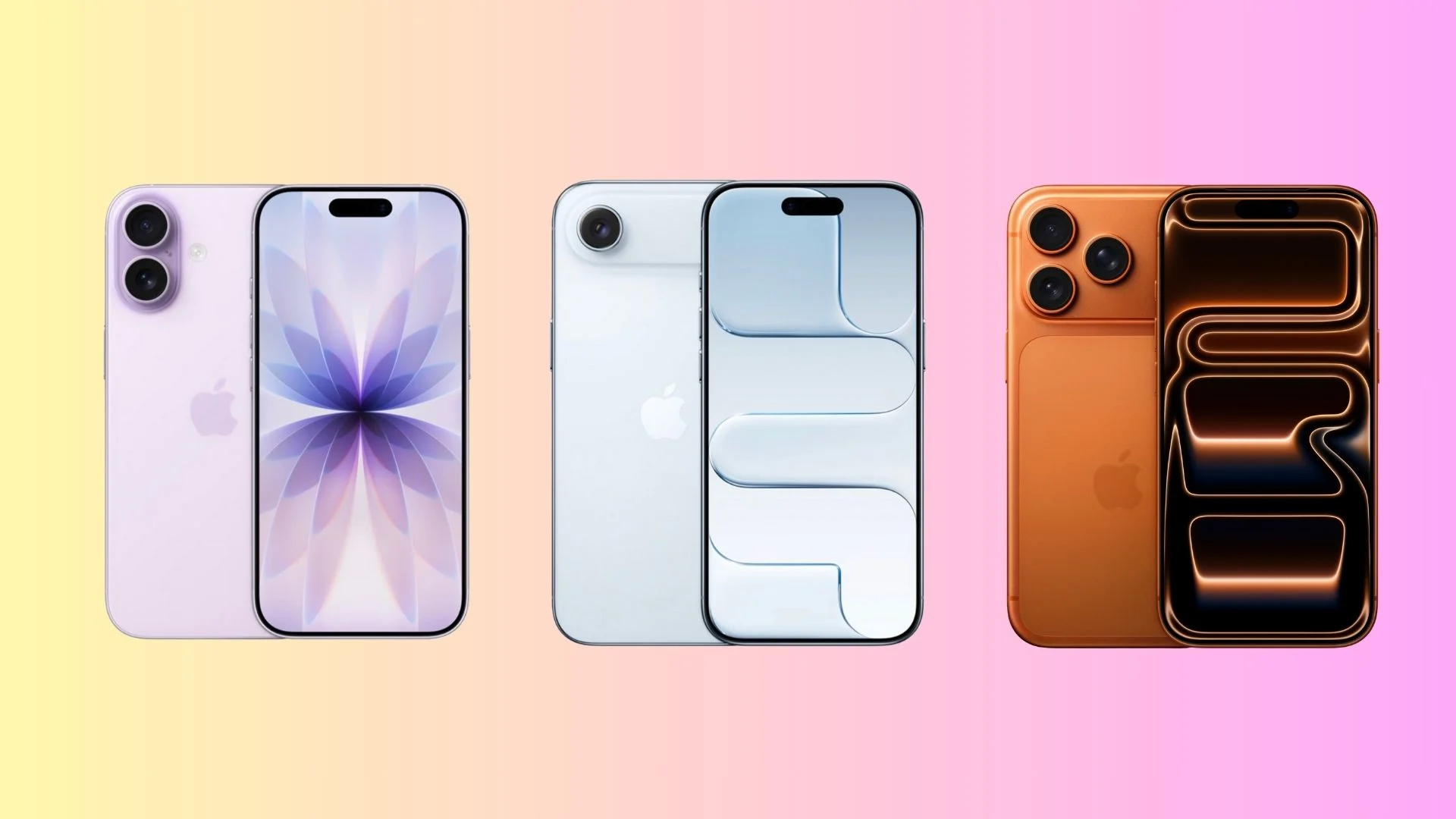
Apple’s 2025 iPhone lineup is its boldest — and most confusing — yet. It offers three distinct models designed to cater to very different kinds of users. From the slim and stylish iPhone Air to the all-out powerhouse iPhone 17 Pro, with the well-balanced iPhone 17 in between, there’s something here for everyone.
But with overlapping features, similar pricing and Apple blurring the lines between Pro and non-Pro models, choosing the right iPhone isn’t as straightforward as it used to be.
This post contains affiliate links. Cult of Mac may earn a commission when you use our links to buy items.
iPhone 17 vs. iPhone 17 Pro vs. iPhone Air
The iPhone 17 is Apple’s new baseline, but it hardly feels entry-level. With a 120Hz ProMotion display, antireflective Ceramic Shield 2 glass, faster charging speeds and 256GB base storage, it finally closes much of the gap with the Pro models. For most people, it delivers the perfect balance of performance, battery life and features without busting the budget.
The iPhone Air, meanwhile, is all about design. At just 6.4mm thin, it’s the slimmest iPhone Apple has ever made — a true statement piece. But that slimness comes with some major compromises.
On the other end of the spectrum, the iPhone 17 Pro goes all-in for enthusiasts, with a telephoto camera upgrade, more RAM, a vapor chamber cooling system, and the best battery life Apple ever delivered in an iPhone.
So, which iPhone should you buy this year?
Table of contents: iPhone 17 vs. iPhone 17 Pro vs. iPhone Air
Design and build
Display
Performance
Cameras
Battery and charging
Pricing
Conclusion
Design and build
iPhone Air: Slimmest and lightest iPhone yet
iPhone 17: Balanced glass and aluminum design
iPhone 17 Pro/Pro Max: Thicker, but new aluminum unibody comes with a superior cooling system (and in bold colors)
At 5.64 mm and 165 grams, the iPhone Air is Apple’s lightest and slimmest iPhone yet. While this might seem like a vanity metric, pick up the iPhone Air, and you’ll instantly understand how these numbers make a big difference in real-life use.
To avoid any Bendgate-style problems, Apple used a titanium frame on the iPhone Air for improved structural rigidity. And early bend tests confirm that Apple’s gamble on the premium metal paid off. The iPhone Air holds up remarkably well, with no signs of flex or weakness.
Yet, the iPhone Air’s slimmness comes with several compromises, including average battery life. For those who want a more balanced device, the iPhone 17 is the better pick. Its glass-and-aluminum design may not be as thin or light as the Air, but at 7.95 mm and 177 grams, it strikes a sweet spot between portability and practicality.
If you don’t care about thickness or weight and want an iPhone that can keep up with your demanding gaming sessions or workloads, pick the iPhone 17 Pro.
True to its name, it packs “pro” features, like the iPhone’s first vapor chamber cooling system and a larger-capacity battery. While the switch from last year’s titanium frame to this year’s aluminum unibody chassis might seem like a downgrade, it comes with several benefits, including better heat dissipation. And for a change, Apple offers the iPhone Pro in a bold color this year: cosmic orange. The Pro models do seem to scratch easily, so that’s something you must keep an eye out for. Or just grab one of Apple’s iPhone cases (on sale now) or one made by other top manufacturers. (Read our buying guide to the best iPhone 17 cases available now.)
Verdict: Choose the iPhone Air if style matters most, the iPhone 17 Pro if you need power and endurance, and the iPhone 17 if you want the perfect balance.
Display
iPhone Air: 6.5-inch 120Hz ProMotion OLED, Ceramic Shield 2 cover glass, 3,000-nit peak brightness
iPhone 17: 6.3-inch 120Hz ProMotion OLED, Ceramic Shield 2 cover glass, 3,000-nit peak brightness
iPhone 17 Pro/Pro Max: 6.3-inch or 6.9-inch 120Hz ProMotion OLED, Ceramic Shield 2 cover glass, 3,000-nit peak brightness
All three iPhones use the same type of display this year, with size being the only difference. The iPhone 17 and 17 Pro both feature a 6.3-inch screen, while the iPhone Air comes with a slightly larger 6.5-inch display. And the iPhone 17 Pro Max comes in at 6.9 inches.
Irrespective of which model you pick, you’ll get a panel that can hit 3,000 nits of peak brightness. Plus, Apple says the new Ceramic Shield 2 cover glass on all three models helps cut down reflections by 33%.
Obviously, if you want an iPhone with the biggest display possible, the iPhone 17 Pro Max is the only choice with its gigantic 6.9-inch screen.
Verdict: No weak link — all three come with excellent screens.
Performance
iPhone 17: A19 chip, 8GB RAM
iPhone Air: A19 Pro with binned 5-core GPU, 12GB RAM
iPhone 17 Pro: A19 Pro with 12GB RAM, vapor cooling system
Apple silicon remains so far ahead of the competition that performance is rarely a concern on the company’s devices. The same holds true for the new A19 and A19 Pro chips that power the iPhone 17, iPhone 17 Pro and iPhone Air.
All three models will deliver the excellent performance we’ve come to expect from iPhones. Your decision will depend on other factors, like your use case, how long you plan to use the phone, etc.
If you’re a professional who frequently uses your iPhone for recording high-quality videos, intensive video editing or serious gaming, the iPhone 17 Pro with its A19 Pro chip is the clear choice. It’s not just about raw chip performance — the extra RAM and advanced cooling system make it better equipped to handle sustained heavy workloads.
Remember that just because the iPhone Air comes with the same A19 Pro chip, that doesn’t mean it will deliver the same level of performance as its Pro sibling. The thinner chassis means there’s not enough room for heat dissipation. So, the device will heat up more quickly under intense loads.
For everyday users — those who mainly chat, browse the web and snap casual photos — the iPhone 17 with its A19 chip is more than enough. Like the other models, its GPU cores even pack Neural Accelerators, bringing a major boost in AI-powered tasks without sacrificing efficiency.
While the maximum storage options on the three phones vary, Apple bumped the base storage to 256GB across the lineup.
From a connectivity viewpoint, the iPhone Air suffers from only one major drawback. It only supports sub-6GHz 5G, missing out on mmWave entirely.
Verdict: Power users/prosumers should lean Pro, and everyone else should stick to the iPhone 17 or iPhone Air.
Cameras: iPhone 17 vs. iPhone 17 Pro vs. iPhone Air
iPhone 17: Dual 48MP main and ultrawide rear cameras
iPhone Air: Single 48MP rear camera
iPhone 17 Pro: Triple 48MP rear setup with upgraded 4x telephoto, pro features like Apple Log 2, ProRAW, ProRes
The camera setup is where the three iPhones differ the most. While all of them feature a 48MP primary rear shooter, there’s more to it than just megapixels. The iPhone Air stands out as the only $999 smartphone on the market with a single rear camera. The Pro, meanwhile, sets itself apart with its advanced camera features and the versatility to shoot anywhere from 0.5x ultrawide to 8x telephoto.
The iPhone 17 provides a decent middle ground, sporting a 48MP primary and 48MP ultrawide shooter.
If you click a lot of pictures, including zooming in on faraway subjects, get the iPhone 17 Pro. It sports a bigger primary 48MP camera, and the new 48MP 4x telephoto shooter uses a 56% bigger sensor for significantly improved image quality. Plus, you get pro features like ProRes, ProRAW and support for Apple Log 2.
If you don’t know what these features are and only use your iPhone’s camera to shoot pictures when on vacation, the iPhone 17 will serve you just fine.
As for the iPhone Air, while that 48MP camera won’t fail to impress you, it does not offer much flexibility. You are limited to clicking pictures at 1x or 2x zoom for the best results.
To Apple’s credit, all three iPhones sport an 18MP Center Stage camera. With it, you can capture more detailed selfies, including shooting them in landscape orientation without rotating the phone. Plus, Center Stage support ensures the camera will automatically pan and adjust to keep you in the center during video calls.
Verdict: Pro dominates, iPhone 17 delivers great everyday shots, Air is good but limited.
Battery and charging
iPhone 17 Pro: Biggest battery, longest life
iPhone 17: Great balance of battery life and fast charging
iPhone Air: Smallest battery, slim MagSafe battery pack helps
The iPhone Air’s slimness comes at the cost of battery life. On paper, Apple claims a video playback runtime of 27 hours for its super-slim iPhone. While impressive, the phone won’t last through a full day of heavy use. Even with above moderate use, you likely will need to juice up the phone late in the evening.
Apple knows this, which is why it created the optional slim iPhone Air MagSafe Battery, which boosts the phone’s battery life by 65%.
The iPhone 17 once again hits the sweet spot, delivering up to 30 hours of video playback, according to Apple. For most users, that’s plenty. Unless you absolutely need the longest-lasting battery, the iPhone 17 will more than hold its own.
If you’re a power user and want your iPhone to last as long as possible, get the iPhone 17 Pro. It packs the biggest battery ever on an iPhone, delivering 33 hours of video playback, Apple says. For an even longer runtime, you can get the iPhone 17 Pro Max.
Another big win with the iPhone 17 and iPhone 17 Pro is faster wired charging. Both devices can now hit 50% in just 20 minutes, making quick top-ups easier than ever.
Verdict: Heavy users → Pro, casual → 17, portability lovers → Air
Pricing: iPhone 17 vs. iPhone 17 Pro vs. iPhone Air
iPhone 17: Starts at $799
iPhone Air: Starts at $999
iPhone 17 Pro: Starts at $1,099
If you’re looking for the most value, the iPhone 17 is the obvious pick. It strikes the best balance between features and price.
The iPhone Air, while stylish, is more of a niche product that comes with compromises in battery and durability. And those compromises can be hard to digest at its $999 price point. But if you are smitten by the Air’s slim design, there’s no other phone that can deliver the same experience.
For power users, professionals or those who simply want the best of what Apple offers, the iPhone 17 Pro is the clear choice.
Verdict: iPhone 17 offers the most value, iPhone Air is niche, iPhone 17 Pro is for enthusiasts
Conclusion: iPhone 17 vs. iPhone 17 Pro vs. iPhone Air
At the end of the day, Apple’s 2025 iPhone lineup covers nearly every type of user. The iPhone 17 is the crowd-pleaser. It gets the biggest upgrades to the non-Pro line in years, with a 120Hz display, faster charging and longer battery life, all at a very reasonable $799 starting price. For most people, this will be the sweet spot. (For more info, read our review: Screen and camera upgrades make iPhone 17 Apple’s best base model ever.)
The iPhone Air is Apple’s boldest experiment this year. It’s stunningly slim and lightweight, easily the most stylish iPhone Apple has ever made. But that design comes with compromises in battery life and camera. If fashion and feel matter more to you than practicality, it’s a tempting pick, but it won’t suit everyone. (For more info, read our review: If you touch an iPhone Air, you’ll want to buy it immediately.)
Finally, the iPhone 17 Pro is for those who want no compromises. It’s thicker, heavier and more expensive, but you’re getting the best cameras, the most power and the longest battery life of the bunch. Creators, power users and anyone who wants the absolute best iPhone experience will find the Pro worth every penny.



